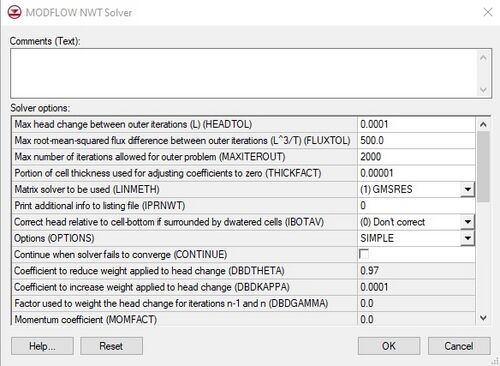GMS:NWT Package
From XMS Wiki
| MODFLOW | |
|---|---|
| Pre-processing | |
| MODFLOW Commands | |
| Building a MODFLOW Model | |
| Map to MODFLOW | |
| Calibration | |
| Packages Supported in GMS | |
| Saving a MODFLOW Simulation | |
| Importing MODFLOW Files | |
| Unsupported MODFLOW Features | |
| Run MODFLOW | |
| Post-processing | |
| MODFLOW Display Options | |
| MODFLOW Post-Processing Viewing Options | |
| Reading a MODFLOW Simulation | |
| Tutorials | |
| Packages | |
| Flow: | BCF6, HUF, LPF, UPW |
| Solvers: | SMS |
| Other: | UZF1 |
The Newton package (NWT) is one of the solvers available in MODFLOW-NWT. The NWT package is only used with the UPW Package. Using the NWT solver requires twice the memory of other MODFLOW solvers because using the Newton method results in an asymmetric matrix. Because of the asymmetric matrix a different matrix solver must be used. The NWT package provides an option to use one of two matrix solvers: a generalized-minimum-residual (GMRES) solver and an Orthomin/stabilized conjugate-gradient solver called χMD (chi-MD).
Contents
General Options
- Comments (Text) – Allows up to 199 characters.
- Max head change between outer iterations (L)(HEADTOL)
- Max root-mean-squared flux difference between outer iterations (L^3/T) (FLUXTOL)
- Max number of iterations allowed for outer problem (MAXITEROUT)
- Portion of cell thickness used for adjusting coefficients to zero (THICKFACT)
- Matrix solver to be used (LINMETH)
- Print additional info to listing file (IPRNWT)
- Correct head relative to cell-bottom if surrounded by d-watered cells (IBOTAV)
- Options (OPTIONS) – Includes four options:
- SPECIFIED – Indicates that the optional solver input values will be entered by the user.
- SIMPLE – Indicates that default solver input values will be defined that work well for nearly linear models.
- MODERATE – Indicates that default solver input values will be defined that work well for moderately nonlinear models.
- COMPLEX – Indicates that default solver input values will be defined that work well for highly nonlinear models.
General Specified Options
- Coefficient to reduce weight applied to head change (DBDTHETA) – Used to control oscillations in head. Values range between 0.0 and 1.0, and larger values increase the weight (decrease under-relaxation) applied to the head change.
- Coefficient to increase weight applied to head change (DBDKAPPA) – Used to control oscillations in head. Values range between 0.0 and 1.0, and larger values increase the weight applied to the head change.
- Factor used to weight the head change for iterations n&ndashl1 and n (DBGGAMMA) – Values range between 0.0 and 1.0, and greater values apply more weight to the head change calculated during iteration n.
- Momentum coefficient (MOMFACT) – Ranges between 0.0 and 1.0. Greater values apply more weight to the head change for iteration n.
- Use residual control (BACKFLAG) – Specify whether residual control will be used.
- 1 = active
- 0 = inactive
- Max number of reductions (backtracks) in head change (MAXBACKITER) – A value between 10 and 50 works well. Only read if residual control is active.
- Proportional decrease in root-mean-squared error (BACKTOL) – Only read if residual control is active.
- Reduction factor for residual control that reduces head change (BACKREDUCE) – Values should be between 0.0 and 1.0, where smaller values result in smaller head-change values. Only read if residual control is active.
GMRES Specified Options
- Max number of iterations for the linear solution (MAXITINNER)
- Method of incomplete factorization used as preconditioner (ILUMETHOD)
- Fill limit for ILUMETHOD 1 or level of fill for ILUMETHOD 2 (LEVFILL)
- Tolerance for convergence of linear solver (STOPTOL)
- Number of iterations between restarts of GMRES (MSDR)
χMD Specified Options
- Acceleration method (IACL)
- Scheme of ordering unknowns (NORDER)
- Level of fill for incomplete LU factorization (LEVEL)
- Number of orthogonalization for the ORTHOMIN acceleration scheme (NORTH)
- Reduced system preconditioning (IREDSYS)
- Use drop tolerance in preconditioning (IDROPTOL)
- Drop tolerance for preconditioning (EPSRN)
- Head closure criteria for inner (linear) iterations (HCLOSEXMD)
- Max number of iterations for linear solution (MXITERXMD)
References
For more information on the NWT package see the USGS documentation at: water.usgs.gov/nrp/gwsoftware/modflow2000/MFDOC/nwt_newton_solver.htm
| GMS – Groundwater Modeling System | ||
|---|---|---|
| Modules: | 2D Grid • 2D Mesh • 2D Scatter Point • 3D Grid • 3D Mesh • 3D Scatter Point • Boreholes • GIS • Map • Solid • TINs • UGrids | |
| Models: | FEFLOW • FEMWATER • HydroGeoSphere • MODAEM • MODFLOW • MODPATH • mod-PATH3DU • MT3DMS • MT3D-USGS • PEST • PHT3D • RT3D • SEAM3D • SEAWAT • SEEP2D • T-PROGS • ZONEBUDGET | |
| Aquaveo | ||
This article is a [stub]. You can help xmswiki by expanding it.
Retrieved from "https://www.xmswiki.com/index.php?title=GMS:NWT_Package&oldid=107674"
Hidden category:
